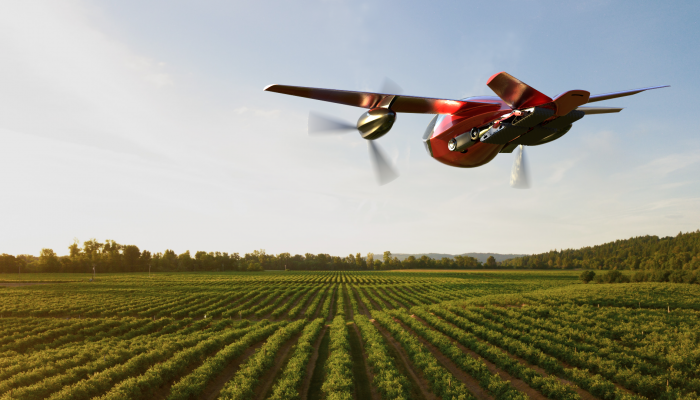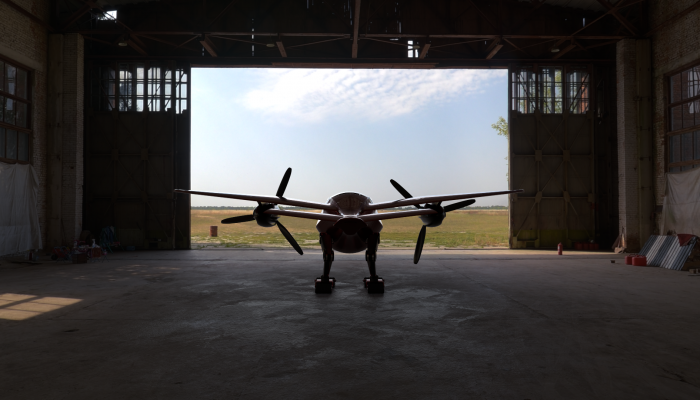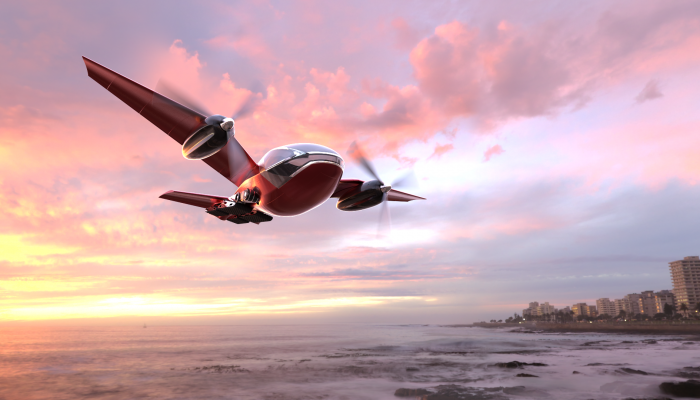Whether you call them “air taxis”, urban air mobility (UAM) vehicles or electric vertical take-off and landing (eVTOL) aircraft, this emerging mode of transport promises smaller infrastructure footprints, sustainable electric innovation, and quicker vertical take-offs and landings.
In the very near future, it could also see eVTOL users commuting swiftly between cities or international tourists transferring to an eVTOL “vertiport” for seamless transport to attractions like the Cape winelands or the Kruger National Park.
China, which aims to have eVTOL aircraft in commercial use by next year, saw the first public test of the four-passenger AutoFlight-made eVTOL between Shenzhen and Zhuhai in February. The route would cut a journey of 70 minutes by boat and more than two hours by car to just 20 minutes, according to the Yicai media agency. Yicai reports that a one-way trip would cost between $28 and $42, in line with the current charge for a ferry ticket and bus combo.
Similarly, US manufacturer Joby Aviation reduced travel time between Manhattan and JFK airport to around seven minutes during a trial of its four-passenger eVTOL in late 2023. According to ANC Digital, by February this year the company was on stage four of a five-stage process towards achieving commercial certification in 2025.
France, meanwhile, aims to become the first city in Europe to make eVTOL flights available to the public during the 2024 Paris Olympics and Paralympics in July and August, respectively. Working with German eVTOL manufacturer Volocopter, the French Civil Aviation Authority, airports operator Groupe ADP, and local authorities in Paris, set routes will be on offer as well as round trips for tourists in the VoloCity two-person flying vehicle.
The European Union Aviation Safety Agency has already published noise standards for eVTOL aircraft, as well as proposals around operational requirements, licencing, and air traffic management, providing a benchmark that the UK Civil Aviation Authority has also adopted.
Given these strides, it is hardly surprising that market research companies such as Marketsandmarkets project significant growth in the eVTOL sector in the coming years. The research consultancy forecasts the global market will be worth $23.4 billion by 2030, from $1.2 billion in 2023, with North America, Europe and Asia leading the way.
Where does Africa stand?
The situation across Africa presents a slightly different context to the rest of the world, but progress has been made in markets such as Kenya, where Kenya Airways subsidiary Fahari Aviation signed a partnership agreement in 2021 with Brazilian aerospace company Embraer’s Eve Urban Air Mobility division to help advance the use of eVTOLs. While further updates have not been forthcoming and Eve Urban Air Mobility did not respond to requests for an interview, Kenya Airways CEO Allan Kilavuka said in 2022 that the airline hoped to test air taxis in 2025.
Similarly, plans by Nigeria-based Titan Air Mobility to address infrastructure and logistics constraints in the West African nation using an eVTOL air cargo concept also highlights the potential to use the new technology to address specific challenges faced by emerging nations. Attempts to secure an interview with Titan to discuss the company’s aim to build “railways in the sky” did not yield fruit.
The founders of South African eVTOL start-up concept Phractyl (a name derived from the mathematical word “fractal”, which seeks patterns amid random chaos) were, however, eager to discuss their labour of love: a 100% electric-powered, bird-shaped flying aircraft called the Macrobat, which has been designed to meet African needs for both safety and controlled landings.
For Vivek Singh, Coert Visser, and Prevani Kistan-Naidoo, the balance between nature and technology sets their bird-like design apart from other eVTOL prototypes. Explaining their approach to this emerging sector, Singh explains, “The marvel of personal flight, realised in a novel way, is important to us. At the same time, the Macrobat is a commercially relevant product, with demonstrable use-case scenarios in agriculture, and the transportation of high-value goods. The aircraft is, therefore, a technology demonstrator that is useful today and, at the same time, informs the design decisions of tomorrow, where fit-for-purpose solutions will follow the evolution of user needs.”
What about regulation?
Like the rest of the world, how Africa steps into this future will necessitate responsiveness on the part of aviation regulations, as overseen by bodies such as the South African Civil Aviation Authority (SACCA) and the Nigerian Civil Aviation Authority.
While the SACAA was not available for comment, Visser explains that when it comes to regulation, all eyes are currently on developments in the northern hemisphere.
“Our take is that locally we will follow what happens internationally. The Europeans and the US are driving the legislative environment. There will be a requirement to certify to operate locally and adhere to the SACAA requirements, but in terms of time scales and concrete mandates, we are not aware of such structured efforts locally compared with what is currently ongoing in Europe, the US and China … where they seem to have fast-tracked this for their local application,” said Visser.
Since eVTOLs would ultimately require their own certification class, which currently does not exist, Visser notes that eVTOL aircraft cannot fly in South African skies. “To our understanding, there is no existing framework for this new class of vehicles in South Africa,” he says.
Elaborating on the regulatory process that awaits, Prevani Kistan-Naidoo explains: “If you look at certification now with drones, it is still very unsure in the South African context and is confined to a certain mass of the vehicle. Plus, you can only fly a drone if you keep it within your line of sight, which means it puts a restriction on the distance as well as how long you can fly. No drone in South Africa can just go up into the air since every time you fly you have to go through a process of getting it accepted to fly. What we are trying to do is a larger mass, also optionally piloted, and to fly into a rural space you have to go beyond visual line of sight. Already that ticks no, no and no.”
This uncertainty may explain why there isn’t more focus in South Africa on this emerging air transport concept.
Bold ambitions
Other factors, says Singh, include the relatively large and established aerospace industry in South Africa and the cost and magnitude of this sort of development project.
“It’s not as simple as a software developer designing an app; it’s a big undertaking,” he says. “I think this is the main reason why you don’t even find established aerospace companies in South Africa doing this sort of thing, because the funding tends to be an issue.”
Singh adds that the community for eVTOL in South Africa is very small, with most companies focusing on smaller drone-type applications, rather than personal aerial mobility.
For this to change, Singh believes the entire transportation system design will need an overhaul.
“It’s the whole ecosystem. It’s not just the aircraft, it’s about battery technology, weather monitoring through crowd-sourcing, it’s about training graduates and prototype-building, it’s about getting tertiary and even secondary institutions involved,” he says of Phractyl’s Africa-focused ecosystem view.
“Our vision is big, it’s ambitious, but that’s what we believe can make a big difference,” says Singh. “We are trying to take advantage of the African environment and build that into the design.”
This means, for instance, that while Europe’s EASA is focusing heavily on issues like noise disturbance as a result of eVTOL roll-out (studies show eVTOL aircraft are considerably less noisy than, for instance, helicopters, see Figure 2), more burning issues in South Africa might include charging challenges due to load-shedding and the use of alternative energy sources
Visser explains that in Africa “we have to build out an ecosystem where you have options to use alternative energy sources which charge back at a lower rate. For instance, with our design, we are considering battery swapping as part of our solution. Effectively, you swap out the battery on landing and take on a new one while the other battery recharges over a longer period using something like a renewable resource.”
This, says Visser, is how Africa can reshape eVTOL craft to address infrastructure deficits and, in the process, transform transport on the continent.
A short history of Phractyl
Vivek Singh met fellow Phractyl founders Coert Visser and Prevani Kistan-Naidoo at Denel Dynamics, where they all worked in same engineering department. In 2017, when General Electric announced an innovation competition aimed at improving Africa, the three joined forces on a personal aerial mobility concept. Given the lack of infrastructure in Africa, the team deemed this a meaningful innovation, and the judging panel agreed.
The prize for winning the challenge was a one-year simulation software license from ANSYS, but the withdrawal of GE from South Africa at the end of 2017 meant the team could not take full advantage of the benefit. However, the trio continued to work on the concept in their spare time and, in 2021, released a video brochure and website – phractyl.com – explaining their design concept for Africa, which included personal transport as well as for uses like infrastructure inspections, agricultural activities such as fertilising, and for emergency medical assistance.
Safety was a significant focus area, which is one reason why the Phractyl Macrobat looks so different from the typical multicopter (wingless) configuration favoured by international designers, explains Singh. “We set out to build safety into the design, so if the propulsion failed there was still a way of landing safely.”
Other design elements were incorporated to suit the unique African context, where unpredictable terrain would be commonplace in rural areas. “Our design means we didn’t have to change any infrastructure to allow for the operation of the vehicle. This means our product could operate in Europe or in the Americas, where there is already infrastructure, as well as in the African environment,” says Singh.
At this point, Phractyl has a digital, simulation model of the Macrobat single-seater unit and a physical 25% scale prototype is currently being built.
What are eVTOLs?
- Electric vertical take-off and landing (eVTOL) aircraft are not drones or helicopters in the traditional sense. They are highly automated, small aircraft that are being dubbed the answer to urban air mobility. Running off batteries and with electric propulsion, these craft have sustainable benefits, are lighter, more manoeuvrable, and capable of flying at lower altitudes.
- While Europe and the US are touting eVTOLs for city transport, in Africa, the potential exists to link rural areas into the existing transport network without the need for significant outlays in airport infrastructure.














